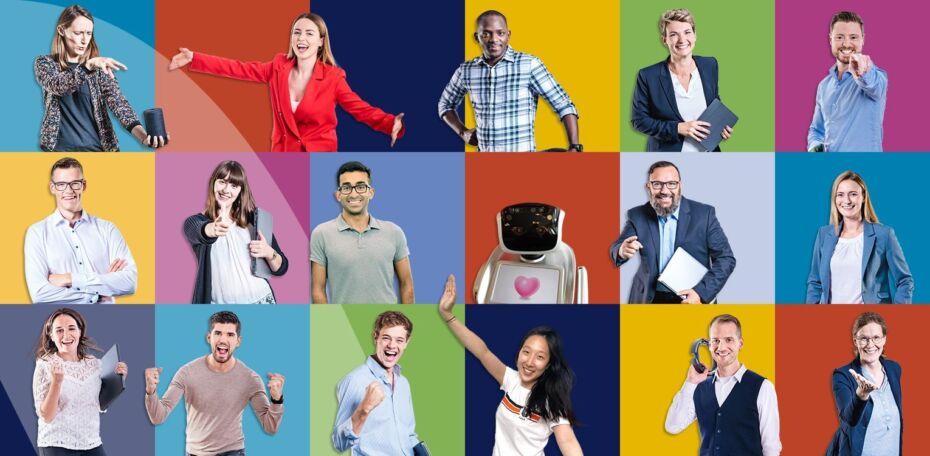Digitization has reached almost every area of life and has become a determining factor of our time – also in the economy. In a way, it is about a comprehensive digital standardization. At the same time there is a call for more diversity. Against this context, the legitimate question arises to what extent the advancing digitization and the simultaneous demand for more diversity interact with each other. The answer shows that they are actually beneficial for one another – if the concepts are implemented correctly.
Digitization and Diversity – How Do They Fit Together?


Innovation Needs Diversity
Albert Einstein once said that it’s madness to do the same things repeatedly and expect different results. Einstein was one of the most important physicists of all time and not an economist of the 21st century, but his basic idea can be applied in an analogy to the development of innovations. This means: Where the consideration of a problem is one-sided and familiar, there is usually no development of an innovative solution to be expected. New things are created by questioning conventional perspectives, by looking at a problem from different perspectives, by synthesizing different ideas into a common solution. In short: No innovation without diversity.
Einstein was able to use his unique, ingenious spirit to develop his innovative ideas. Of course, we also use our minds. In addition, today we also like to make use of the technical possibilities that have arisen from digitization. For example by working in a team with robots and using the potential of artificial intelligence. In this way the working world is becoming increasingly digital.
But to achieve more diversity with digitization, it is already required in the development of new systems and the optimization of existing ones. Otherwise, even artificial intelligence can have a limited view of the world and people. For example, ‘algorithmic bias’ is based on a lack of diversity in the creation, preparation and processing of data. The result is unequal treatment of users. When used as part of an application process, a system with algorithmic bias could maintain stereotypes and make decisions on this basis that have serious consequences.
Diversity in the Age of Digitization
Digitization has not only turned our private life upside down, but it has also permanently and structurally changed the world of work. All the digital tools available make it possible that, in many cases, we can do our work anytime and anywhere. A new level of flexibility seems to have been achieved, which can be seen, among other things, in the emergence of concepts such as ‘New Work’ and the now well-known home office. Due to the technical possibilities, digitization has therefore contributed to the creation of new and more flexible working models, which in turn provide more opportunities for diverse people to work together.
During digitization, a new talent pool has developed that ensures more diversity in the world of work. For example, people who were unable to work due to a handicap can return to work thanks to digital assistance systems. In addition, conference and video systems provide the framework for digital meetings in real time that can take place around the world. Meetings can be held much more efficiently and thus increase the influence of new perspectives and ideas.
On the other hand, there is the risk of new inequality: People with no or limited access to digital systems are threatened with the exclusion of work processes and meetings. To remedy this, identical technical prerequisites must be created when it comes to the availability of end devices and the associated infrastructure.

New Working Models on the Upswing
Whether new work, flexibility or the home office – none of these are completely new terms in the modern world of work. But it can be said without a doubt that the initiatives have experienced a real boom since the outbreak of the corona pandemic, because many employees had to swap the office for their private home overnight and for many the dining table became a desk. From now on, companies were therefore ‘forced’ to react quickly to counter the technical effects of the pandemic with innovative and flexible solutions – a fact that promoted the establishment and rapid development of flexible concepts. Fortunately, thanks to the technical possibilities available, the sudden changeover to ‘new’ working models was often easily feasible, so that a regulated workflow could be digitally ensured. In this respect, the technical possibilities in the age of digitization can be seen as a real blessing in times of crisis.
During the pandemic, many companies put together teams to develop innovative ideas for coping with the crisis – usually with the help of video telephony tools. The cooperation of different people from different disciplines proved to be extremely beneficial for the development of creative solutions. Another positive effect is that the virtual collaboration between colleagues from different positions has also helped to break down hurdles and hierarchies in companies.
Do New Working Models Mean Old Distribution of Roles?
The pandemic acts like an accelerator on the concepts of ‘New Work’ and ‘Flexibility’ and thereby promotes diversity in the economy. Due to the great popularity that enjoys the flexible working models, it can be assumed that even after the pandemic, many employees will at least partially swap the office for the home office. For this reason, the pandemic-induced development of flexible working models should be viewed less as a temporary trend and more as a long-term restructuring.
There are both opportunities and risks in the remote work. For example, the sudden switch to working from home has torn numerous women from everyday office life and suddenly catapulted them into the home environment – a step backwards in terms of gender diversity and equality?
It may be that traditional gender roles were resumed or strengthened for a short time by working in one’s own four walls, but the more digitization advances and new forms of participation in work emerge, the less outdated role stereotypes are likely to be of relevance. In any case, it becomes clear that against this background there is still a need for action to overcome stereotypes of roles. Contemporary models must be established that create new ways of combining home office and private life – for everyone.

Digitization and Diversity: A Start Must Be Made
The use of digital systems such as video telephony, cloud servers or artificial intelligence can be helpful tools to reduce inequalities and overcome stereotypes. But diversity, equity and inclusion must be lived before they can be used: As part of the development team, involved in data collection and processing and with identical technical requirements, people of all groups can benefit equally from digitization and use it advantageously.
Find out how we benefit from our growing diverse workforce and how we would like to contribute to it.





